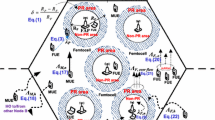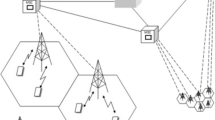Abstract
In this paper, we develop an efficient Call Admission Control (cac) algorithm forumts systems. We first introduce the expressions that we developed for Signal-to-Interference (sir) for both uplink and downlink, to obtain a novelcac algorithm that takes into account, in addition tosir constraints, the effects of mobility, coverage as well as the wired capacity behind the base station, for the uplink, and the maximal transmission power of the base station, for the downlink. As of its implementation, we investigate the measurement-based approach as a means to predict future, both handoff and new, call arrivals and thus manage different priority levels depending on a tunable coefficient. Compared to classicalcac algorithms, ourcac mechanism achieves better performance in terms of outage probability and QoS management.
Résumé
Dans cet article, on développe un algorithme de commande de l’admission des appels pour les systèmesumts. On introduit d’abord les expressions du rapport signal utile/signal sur brouillage (sir) pour les liaisons montantes et descendantes, pour obtenir un algorithme d’admission qui prenne en compte non seulement les contraintessir mais aussi les effets de mobilité, de couverture, de capacité des liaisons filaires au-delà de la station de base pour la liaison montante, et de puissance de transmission maximale de la station de base pour la liaison descendante. Du point de vue de son implémentation, on étudie une approche fondée sur des mesures comme moyen de prédire les arrivées des appels (nouveaux ou provenant de transferts) et gérer ainsi différents niveaux de priorité en fonction d’un coefficient ajustable. Lorsqu’on le compare aux algorithmes classiques, notre mécanisme de commande d’admission obtient de meilleures performances en termes de gestion de la qualité de service et de probabilité de panne.
Similar content being viewed by others
References
Elayoubi (S.),Chahed (T.),Hebuterne (G.), On the Capacity of Multi-cellumts,ieee Globecom 2003, San Francisco, December 2003.
Kiran, Tse (D.N.), Effective Interference and Effective Bandwidth of Linear Multiuser Receivers in Asynchronouscdma Systems,ieee transactions on information theory,46, no 4, July 2000.
Leong (C.),Zhuang (W.), Call Admission Control for Voice and data traffic in wireless communications,Computer communications, 2001.
Bartolini (N.),Chlamtak (I.), Call Admission Control in Wireless Multimedia Networks,ieee pimrc’2002.
Ma (Y.),Han (J.J.),Trivedi (K.S.), Call admission control for reducing dropped calls incdma cellular systems,Computer communications, 2001.
Huang (C.),Yates (R.), Call Admission in Power Controlledcdma systems,ieee vtc 1996.
Capone (A.),Redana (S.), Call Admission Techniques forumts,ieee vtc 2001Fall.
Ho (C.J.),Copeland (J.A.),Lea (C.T.),Stuber (G.L.), On Call Admission Control inds/cdma Cellular Networks,ieee transactions on Vehicular Technology,50, no 6, November 2001.
Dimitriou (N.),Sfikas (G.),Tafazolli (R.), Call Admission Policies forumts,ieee vtc 2000-Spring, Tokyo.
Dimitriou (N.),Sfikas (G.),Tafazolli (R.), Quality of service for multimediacdma,ieee Communications Magazine,38 Issue: 7, July 2000.
Kasera (5K.),Ramjee (R.),Thuel (S.),Wang (X.), Congestion Control Policies forip-basedcdma Radio Access Networks,ieee info com 2003.
Mueckenheim (J.),Bernhard (U.),Pampel (H.),Gunreben (P.), Performance Evaluation of Connection Admission Control forw-cdma Networks using dynamic system simulations,ieee scvt 2000.
Jeon (W.),Jeong (D.), Call admission control for mobile multimedia communications with traffic asymmetry between uplink and downlink,ieee Transactions on Vehicular Technology,50 Issue: 1, January 2001.
Kim (I.),Shin (B.),Lee (D.),sir-Based Call Admission Control by Intercell Interference Prediction fords-cdma Systems,ieee communications Letters,4, no 1, January 2000.
Holma (H.),Toskala (A.),w-cdma forumts. Radio Access for Third Generation Mobile Communications,John Wiley and Sons, England, August 2000.
Liu (Z.),Elzarki (M.),sir-Based Call Admission Control fords-cdma Cellular Systems,ieee Journal on Selected Areas in Telecommunications, May 1994.
Blogh (J.S.),Hanzo (L.), Third Generation Systems and Intelligent Wireless Networking,John Wiley and Sons, England, 2002.
Viterbi (A.J.),cdma Principles of Spread Spectrum Communication,Addison-Wesley Wireless Communications Series, March 1997.
Baxter (N.),Chien (H.),Loreen (A.),Opnet Tutorial Manual,mil 3, Washington D.C.
Author information
Authors and Affiliations
Rights and permissions
About this article
Cite this article
Elayoubi, SE., Chahed, T., Tlais, M. et al. Measurement-based admission control in UMTS. Ann. Télécommun. 59, 1433–1445 (2004). https://doi.org/10.1007/BF03179729
Received:
Accepted:
Issue Date:
DOI: https://doi.org/10.1007/BF03179729
Key words
- umts
- Traffic control
- Cellular network
- Signal interference
- Call processing
- Heterogeneous traffic
- cdma
- Priority
- Radio communication handover




